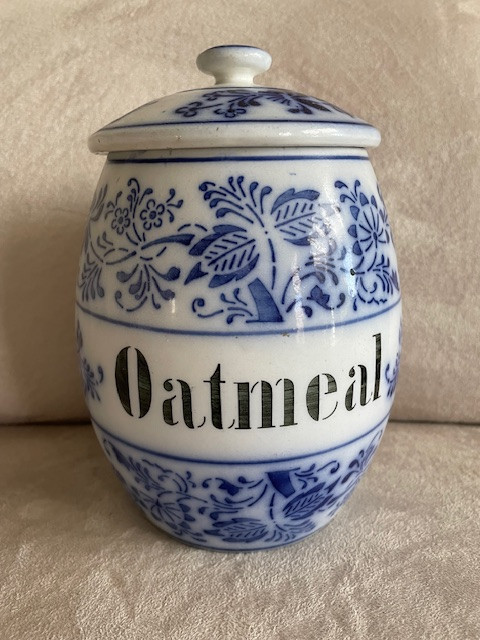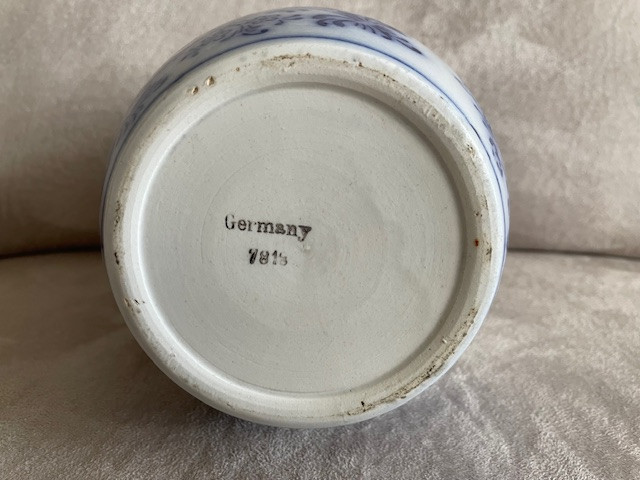Description *
Blue and white "Blue Onion" pattern porcelain Oatmeal canister with lid.
Category *
Ceramics and Porcelains
Medium
Porcelain
Distinguishing marks
Stamped on bottom with country of origin, Germany, and number 781's (s may be an 8)
Condition
Excellent
Size and dimensions of this item
7-1/2 inches tall X 5 inches in diameter
Date Period
Unknown
Weight
1 lb. 8.7 oz.
History
Age unknown. I inherited it in 1980 from my mother who inherited it from her mother.
Price Paid (If known)
Unknown
For Sale?
No



Blue Onion Porcelain Oatmeal Canister (Germany)
Identification & Description:
This is a blue and white porcelain oatmeal canister in the “Blue Onion” pattern, marked Germany on the base along with the impressed or stamped number 781’s (or possibly 7818). The design features stylized floral and leaf motifs typical of the Blue Onion (Zwiebelmuster) pattern, which originated in Meissen porcelain in the 18th century and has been widely reproduced in Germany and other European countries.
Origin & Date Period:
The Germany mark (without “West” or “East”) suggests manufacture prior to the division of Germany in 1949, or after reunification in 1990. Given the style, glaze, and font, it is more likely pre-WWII (circa 1900–1930), possibly from a porcelain maker in the Thuringia or Saxony region. The impressed or stamped number is likely a mold or pattern reference rather than a date code.
History & Use:
Such canisters were part of larger German kitchen storage sets, often including labeled jars for flour, sugar, rice, coffee, and spices. They were designed for practical use but are now collected for their decorative value and craftsmanship. Your family provenance — passed down from your grandmother to your mother and then to you — supports an early 20th-century acquisition.
Condition:
The piece appears to be in excellent condition, with no visible cracks, chips, or glaze loss. Retention of the original lid is significant for value.
Current Market Value:
Values for authentic antique German Blue Onion kitchen canisters vary depending on maker, condition, rarity of the label (“Oatmeal” is less common than “Rice” or “Flour”), and whether they are part of a complete set. Based on recent sales:
Authentication Notes:
While the style and mark are consistent with German porcelain from the early 20th century, identifying the exact maker (e.g., Meissen, C.A. Schramberg, or other Saxon/Thuringian factories) would require expert examination. A professional porcelain appraiser or auction house specializing in European ceramics could provide definitive authentication.
Recommendation:
Given the condition, provenance, and potential age, you may wish to have it professionally appraised if you ever decide to insure it or sell it, especially if you possess more canisters from the same set.
Some Additional Information That May Prove Helpful
German Porcelain Maker’s Mark Reference Chart (Blue Onion–Style Kitchenware)
Manufacturer: C.A. Schramberg (Schramberger Majolikafabrik)
Marking Style (1900–1930s): “Germany” stamped in serif letters; sometimes includes mold numbers underneath
Notes: Produced Blue Onion and floral kitchen canisters in the 1910–1930 period; often labeled in English for export
Likelihood for This Canister: Medium – English “Oatmeal” label fits export profile
Manufacturer: Villeroy & Boch (Mettlach)
Marking Style (1900–1930s): Often impressed or stamped “Germany” with a 3–5 digit mold number; no crest on utilitarian wares
Notes: Made many export kitchen sets with stenciled English labels
Likelihood for This Canister: High – mark’s simplicity and numbering are consistent
Manufacturer: Seltmann Weiden
Marking Style (1900–1930s): “Germany” in small serif font, sometimes with pattern number
Notes: Produced Blue Onion kitchenware in the 1920s–30s; labels often in German, but English labels for export exist
Likelihood for This Canister: Medium
Manufacturer: Bavaria region makers (e.g., Jaeger & Co., Winterling)
Marking Style (1900–1930s): “Germany” stamp, sometimes with “Bavaria” or floral mark; mold numbers below
Notes: Many exported blue-and-white canisters, sometimes English-labeled
Likelihood for This Canister: Medium-low (most included “Bavaria” if for export)
Manufacturer: Wallendorf
Marking Style (1900–1930s): Simple “Germany” mark; mold or style number impressed
Notes: Less common for kitchen canisters, but possible
Likelihood for This Canister: Low
Manufacturer: Reinhold Schlegelmilch (R.S. Prussia / R.S. Germany)
Marking Style (1900–1930s): Usually ornate “RS Germany” in wreath; rarely just “Germany”
Notes: Known for fine porcelain; rare for utilitarian canisters
Likelihood for This Canister: Low
Manufacturer: Meissen (post-1800s exports)
Marking Style (1900–1930s): Crossed swords mark; export pieces could be marked “Germany”
Notes: Would always include swords logo; not the case here
Likelihood for This Canister: Very low
How to Narrow It Down:
Recommendation:
AI Appraisal: Porcelain Blue Onion canister
🤖 AI EXPERT APPRAISAL
Confidence Level: 70%
Appraisal for Porcelain Blue Onion CanisterCategory: Kitchenware
Physical Description: This porcelain canister features the classic "Blue Onion" pattern, characterized by intricate blue floral designs. It stands at 7.5 inches tall and has a diameter of 5 inches. The canister is topped with a matching lid, also adorned with blue motifs. The base is stamped with the country of origin, Germany, along with the identifier '781's'.
Condition Assessment: The canister is in good condition overall, with minor wear consistent with age. There are a few small blemishes and some discoloration on the base, likely from storage. The lid fits securely, and there are no visible cracks or chips in the porcelain.
Historical Context: The "Blue Onion" pattern is a well-known design originating from the 18th century, primarily associated with German porcelain manufacturers. It gained popularity due to its delicate artistry and has been produced by various companies over the years, including Meissen and Royal Copenhagen. This particular piece likely dates from the mid-20th century, as indicated by the manufacturing style and markings.
Collector Appeal: Collectors value the "Blue Onion" pattern for its aesthetic appeal and historical significance. The design is emblematic of the European porcelain tradition, and its rarity can make certain pieces highly sought after. Items in this pattern often reflect trends in both decorative arts and kitchenware, making them desirable for collectors of both categories.
Interesting Facts: The "Blue Onion" pattern is not just a decorative motif; it has a rich history that reflects trade routes and cultural exchanges between Europe and Asia. The design is inspired by Chinese porcelain, which was highly prized in Europe during the 17th and 18th centuries.
Comparable Sales:
Valuation Range: Based on the condition, historical significance, and comparable sales, the estimated value of this canister is between $30 and $50. The confidence in this valuation is moderate, given the variability in the market for similar items.
Confidence Score: 0.7
Disclaimers: This appraisal is a preliminary assessment and should not be considered a definitive authentication. For a thorough evaluation, professional appraisal services are recommended.
💰 ESTIMATED VALUE
$30 - $50
📋 Important Note:
This AI-generated appraisal is based on the provided information and 2 submitted photos. For high-value items or final authentication, please consult with a certified human appraiser.